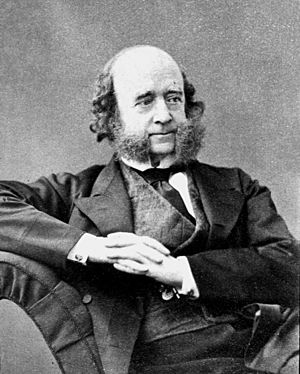Arthur Farre facts for kids
Arthur Farre (born March 6, 1811, in London – died December 17, 1887, in London) was an English doctor who specialized in helping women during childbirth. This area of medicine is called obstetrics. He was also a Fellow of the Royal Society, which is a very important group for scientists.
Contents
About Arthur Farre
Arthur Farre was born in London in 1811. His father, Dr. John Richard Farre, was also a doctor. Arthur went to Charterhouse School and then studied at Caius College, Cambridge. He later studied medicine at St. Bartholomew's Hospital.
His Medical Career
Arthur Farre earned his first medical degree in 1833 and a higher one in 1841. He became a fellow of the Royal College of Physicians in 1843. This meant he was a highly respected doctor.
From 1838 to 1840, he taught about forensic medicine, which is using medical knowledge to solve legal questions. In 1841, he became a professor at King's College. He taught about obstetric medicine and helped deliver babies at King's College Hospital until 1862.
He also held important roles at the Royal College of Physicians, like being an examiner. He was even chosen to give a special speech called the Harveian orator in 1872.
A Stand for Women in Medicine
For many years, from 1852 to 1875, Dr. Farre was an examiner for doctors who wanted to specialize in childbirth. He and his colleagues, William Overend Priestley and Robert Barnes, resigned from their positions. They did this to protest against women, like Sophia Jex-Blake, being allowed to take the exams in childbirth. They believed that women should not be allowed to become doctors, even if they had other medical training.
However, their protest did not stop progress for long. It actually encouraged the government to pass a law in 1876, called the Russell Gurney Act. This law made it possible for women to get medical qualifications.
Doctor to the Royal Family
Arthur Farre was a very successful doctor. He helped deliver babies for important people, including the Princess of Wales and other members of the royal family. Because of his excellent work, he was made a special physician to Queen Victoria.
When another famous doctor, Sir Charles Locock, passed away in 1875, Dr. Farre became the honorary president of the Obstetrical Society of London. He gave the society his collection of models and casts related to the female body, which were very helpful for teaching.
Arthur Farre passed away in London on December 17, 1887. He was buried at Kensal Green. He did not have any children, and his wife died before him.
His Contributions to Medicine
Arthur Farre's most important written work was a long article called ‘The Uterus and its Appendages.’ This article was part of a large medical book called Cyclopædia of Anatomy and Physiology, published in 1858. It was a detailed study of the female reproductive organs.
He also wrote papers about microscopy, which is the study of very small things using a microscope. He shared these papers in the Royal Microscopical Society's Journal and Transactions. He was even the president of this society in 1851 and 1852. One of his early papers, published in 1837, was about the tiny structures of certain sea creatures called Polypi. This paper was so good that it helped him become a member of the Royal Society in 1839.
Images for kids



